
a collection of notes on areas of personal interest
- Introduction
- Arabic / Islamic design
- Arabic / Islamic geometry 01
- Arabic / Islamic geometry 02
- Arabic / Islamic geometry 03
- Arabic / Islamic geometry 04
- Islamic architecture
- Islamic urban design 01
- Islamic urban design 02
- Islamic urban design 03
- Islamic urban design 04
- Islamic urban design 05
- Arabic / Islamic gardens
- Gulf architecture 01
- Gulf architecture 02
- Gulf architecture 03
- Gulf architecture 04
- Gulf architecture 05
- Gulf architecture 06
- Gulf architecture 07
- Gulf architecture 08
- Infrastructure development
- The building industry
- Environmental control
- Perception
- The household on its lot
- A new approach – conceptual
- A new approach – principles
- A new approach – details
- Al Salata al jadida
- Public housing
- Expatriate housing study
- Apartment housing
- Pressures for change
- The State’s administration
- Society 01
- Society 02
- Society 03
- Society 04
- Society 05
- Society 06
- History of the peninsula
- Geography
- Planning 01
- Planning 02
- Population
- Traditional boats
- Boat types
- Old Qatar 01
- Old Qatar 02
- Security
- Protection
- Design brief
- Design elements
- Building regulations
- Glossary
- Glossary addendum
- References
- References addendum
- Links to other sites
Leisure

There seems to be a preponderance of passive over active recreation, particularly with regard to games, and this is carried over with children into their teens and beyond. Children have become accustomed to being driven by drivers or not to make a journey at all. Sport is encouraged at School but child obesity – a function of poor diet and lack of exercise – is now noticeable and the weather is not always conducive to exercise. There are a number of clubs for Qataris that are patronised particularly by teenagers. In the past these had a strong social role as a meeting ground and, because of this, have been associated with political unrest as well as social problems. Football and basketball are particularly liked and followed by all, each club having teams.
Teenagers have the same games and pursuits they always had though they are heavily dependent on owning or using a car for a lot of their activities. A car is acquired as soon as possible and driven, sometimes under age. Traffic laws are not scrupulously upheld, and there is a feeling that the modern car is, perhaps, the counterpart of the horse or camel in that it is the natural requirement that marks the man. It is interesting to see the two modes of transport side by side as here where a driver is adjusting his tyres for the soft sand. Nowadays, it seems, most teenagers are more oriented towards sport though many continue to use the desert for leisure activities.
This follows through to the adult where cars are a very potent symbol of power and mobility. Import papers stuck to windows are kept as long as possible to demonstrate that a car is newly acquired. Many sports can be followed in Qatar, but only a handful of adults pursue them, and these would be mainly football, tennis, sailing or body-building. There are a small number of Qataris who are active in sport after marriage, but they are few and far between and tend to be those at the upper end of the socio-economic scale.
The process of opening up Qatar to the outside world has seen significant developments in the provision of sports. But these are sports played at an international level: tennis, motorcycling, motorboat racing and the like which are televised to a national and international audience. They bring identification with Qatar, but they mainly encourage passive viewing.

The desert and the sea are the two areas that still draw the adult Qatari in his free time. In general it is true that the badu families are drawn to the desert and the littoral families to the sea, but this is not always the case with many of the latter developing farms inland and the former developing houses on the sea side within the constraints of their limited availability and Government regulation. This example shows the idyllic setting that many enjoy: tents beside the sea with the grazing brought by the winter rains. The tents may stay there for the whole of the season with members of the family commuting if they have work in town. It is the equivalent of the West’s second home syndrome, but without the permanent footprint. Elsewhere i have talked about the main Qatari families and their geographic relationship with the peninsula. I should add here that there is still this feeling of ownership and many families will feel themselves limited to the areas their tribe had a notional right to.

Some are able to capitalise on land they have, or believe they have, a right to and have been able to establish a more permanent structure than a tent. Both the tents above and this shack have exactly the same spirit behind them though the tent has, perhaps, the more romantic look both in terms of its appearance compared with a permanent structure as well as in its capability to respond to the particular environmental conditions of the littoral. However, here somebody has developed a structure which has the advantages of electricity – witness the television dishes – water tanks and, a most important element, two trees, one I think an acacia, the other a palm. It is an idealised place to rest from the increasingly busy pace of life in the city and one increasingly sought by Qataris. The extraordinarily rapid urbanisation has now made this an imperative for many.


The desert exerts an attraction for many who wish to be able to experience the smells of the clean air and the taste of the well water together with other natural characteristics of the desert, particularly its sense of space. The air tastes – this is the preferred Arabic word – different according to the area of the peninsula, the time of year and the amount of wind and humidity.
In the first photograph, taken in February 1982, a number of Qatari families have come to a small water-filled wadi in the north of the country in order to picnic while enjoying this seasonal feature. This is a common sight in winter months and is usually associated with the activity of searching for the fuqa, a naturally growing and highly prized delicacy, at this time of the year. The lower photograph, taken in February 1983, is of the women and children of a Qatari family fuqa hunting on the west side of the peninsula near Dukhan.
The Qatar desert is not large and now has a number of restrictions as well as encroaching urbanisation. Although the State is confined to a narrow peninsula, there remains a very strong feeling that, to Qataris, the peninsula is an extension of the ruba’a al-khali or Empty Quarter of Saudi Arabia and is accessible psychologically as well as, in a few cases, literally. Bear in mind that the badu annually ran their animals in and out of the peninsula, and the border is patrolled on both sides by guards drawn, in the main, from the same families who made these annual migrations.
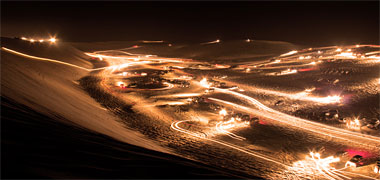
But the desert is also enjoyed in a different way nowadays. Access to it brought about by a combination of increased wealth, the availability of four-wheel drive vehicles, and more leisure time has enabled many to enjoy themselves in a different way. Khor al-Udeid in the south of the peninsula has been effectively designated a touristic area, as they term it. The sand dunes are regarded as a recreational facility and advantage is taken of them to provide a break for those working and living in Qatar. It is certainly different from the traditional pursuit of leisure in the desert.
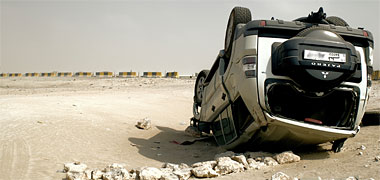
Because of the availability of four-wheeled vehicles and the cultural tradition of roaming in the desert, many take advantage of the desert to travel off-road. Although the desert is relatively flat – with the exception of the sand dunes in the south of the peninsula – it is littered with limestone rocks of various sizes, and an irregular surface which can catch out the unwary. A number of people have been injured or killed driving in the desert; and I have seen vehicles driven at speed with the driver holding a hawk on his wrist while looking for his quarry. Having said that, my experience is that Qataris tend to be excellent at driving in the desert with a very good eye for the irregularities of the surface conditions. This driver, appears not to have been one of them.
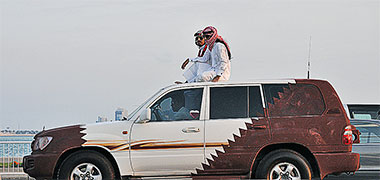
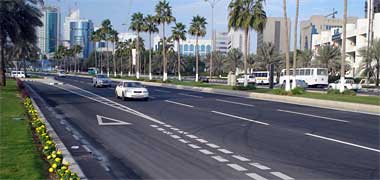

In a sense the car is the replacement for the camel or horse and has taken a very important place in the psyche of its owner. Considerable efforts are made to present the car as an extension of the owner. This is really no different from the manner in which many in the West relate to their cars, nor is the way in which they are used. Cars are prized for being new, and attempts made to retain the idea of their being newly bought. They are also decorated, particularly on special occasions as in this top photograph, taken on National Day. The distances for travel and the heat make some form of vehicle a necessity for everybody, but cars also have a recreational aspect to them. Two paragraphs above there is a photo of the way in which the sand dunes are used, but there is also significant activity on some roads at night where young men compete in driving their cars in a variety of eccentric styles including driving on two wheels. This practice has spread rapidly through the Gulf and is the subject of many film clips on the Internet. Here, in the middle photograph, taken on the Corniche, you can see some minor marks left by drivers spinning their cars. Generally this sport is carried out on quieter roads but, as can be seen in the lower photograph, the opportunity can often be taken to show driving skills in broad daylight.

Earlier I mentioned that there were two great resources for both young and old Qataris to enjoy in their leisure and recreation: the desert and sea. In many ways they enjoy similarities in that they form the setting for so much of the traditional way of life, they are areas of potential danger for those without the necessary skills and experience yet, in particular, they are places where the pressures of urban life and its stresses can be dissipated. It is no wonder that they are so well enjoyed. This photograph illustrates a little of that feeling. Four Qataris lounge comfortably on their shuw’i as it moves out to sea. Complete with a large, enclosed cabin with air-conditioning and modern navigating equipment, it is a comfortable platform from which to enjoy the sea and its passive and active opportunities.
Falconry
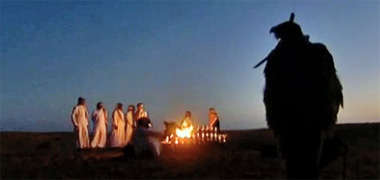
Here is an photograph of traditional camping in the desert with a group standing around the fire, a row of a dellaal set up for the preparation and serving of qahwa, and a hawk silhouetted against the sky at dusk. It needs only a saluqi lying by the fire, a group of camels hobbled in the background and, perhaps, a horse or two to complete the idyllic and romantic picture of desert life.
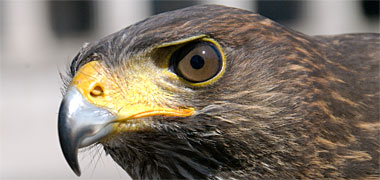

Traditional pursuits such as falconry – qanas – are still followed, but only in season and most notably outside the country as there is little left to hunt in Qatar. Some Qataris still take a lot of interest in hunting with falcons and salqan, and all are aware of this important facet of their heritage. The saqr falcon, falco cherruq, particularly the female hurr is preferred to the peregrine falcon, falco peregrinus, the female – in common with the hurr and also preferred to the male – being known as a shaheen, as it too is considered to be more intelligent, aggressive and has better tolerance to stress. It is the traditional falcon that has been used in the desert for centuries, and it is the female of both types that is preferred for hunting. Incidentally, I shall use the term shaheen for hawks generally as that seems to be the name I have heard used for hawks collectively in ordinary conversation. The first of these two photographs is of a Harris hawk, and is placed here to give an indication of the character and strength of the eyes and beak of a hawk. The second photograph shows a group of hawks, each sitting on its own wakr, and waiting to be exercised.

Training has to be constant and is carried out using pigeons as the hawks’ readily-available quarry. In the hunting season, which begins around November, it is common to see birds being flown in the desert as it is necessary to exercise them every day if they are to be kept fit and effective. The natural setting of the desert is the obvious place for this training but is decreasing in effective size with increasing urbanisation and the burgeoning population with vehicles capable of travelling anywhere in the peninsula.

The better hawks are brought up by their handlers who will live with them in order to create, develop and reinforce the bond which is important in patterning their behaviour. It is difficult to underestimate the attraction of hawks to their handlers and owners. The owners of the hawks will take as much time as possible to travel into the desert in order to fly their hawks and to enjoy the feeling of freedom that is commonly found in the desert. Here a hawk is being flow while its owner and friends watch.

Here is part of the same group of Qataris about to move off to a new location at which to fly their hawks. While hawks are usually transported in vehicles sitting on hessian-covered bars on the back seat, it is not an uncommon sight to see birds being held on the left forearm by the driver of a four-wheel drive vehicle. But it is a dangerous practice and has led to both injury and death as the single-handed driver must continually scan both the sky and land as the vehicle is manoeuvred after potential or actual quarry, often at relatively high speeds.

The bustard, hubara – one seen here attempting to hide beneath a thorn bush – is the traditional quarry of the falcons, as is the desert hare, arnab, but few of either are found in Qatar and smaller wild birds have to be relied on in addition to pigeons. The hubara is a very large bird and, while slower than a falcon and apparently ungainly, is highly manoeuverable in flight and goes to ground readily, making it difficult for the falcon both to follow and to strike. Generally hawks will not start their attacks from great heights and much of the attack occurs at lower heights where the hubara is attempting to shake off the hawk. It is also a fact that different types of hawk have different patterns of attack, this having much to do with the shape of the different hawks’ bodies and, particularly, the forms in which their wings and tail feathers have developed.

When the hawk brings its quarry down it will then want to eat it straight away. Here a Qatari sits in the desert with his hawk eating, its wings partially spread in the pattern characteristic of protecting its food, a practice which is known as ‘mantling’ and is understood to shield the food from sight of other predators. The photo also shows something of the strong bond that develops between a hawk and its owner or handler.


The birds are either taken as young from their nests or trapped abroad as mature birds. Normally the falconer spends all his time with his birds in the same manner as has been practised for centuries because it is only when trust and understanding has developed between the falconer and his bird that the sport of hunting can really take place. The birds are well treated, living and travelling with their handlers in some degree of comfort, and owners spend much of their time in season handling the birds and talking about them with friends. This often takes place inside with the wakr on which the birds stand being stuck into a sand-filled concrete building block, or similar support on the terrazzo or marble finished floor and the bird wearing its traditional burq’a designed to keep it calm by preventing its natural tendency to scan for prey. This pair of photographs illustrate two of these devices and are of relatively standard design. Some burq’a can be extremely expensive, their cost related to the value of the bird they hood, some of which are extremely expensive.

This first photograph is of a typical desert scene where a number of falcons have been taken out for their daily exercise to a part of the desert where there is no other activity to provide a distraction. Two birds each sit on a wakr in the shade provided by a four-wheel drive vehicle while a third is being handled in the background. The wakr is usually a turned wood perch, padded at the top to enable the hawks to obtain a firm grip, and with a steel spike at the bottom to drive into the desert surface and create a stable perch.
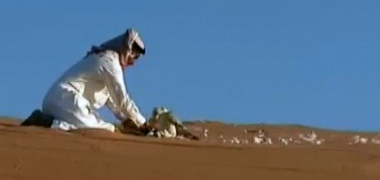
Following a kill it is important for the handler to go to the hawk as soon as the bird settles on the ground. Here a trail of the feathers from the quarry is evident on the sand suggesting, not unnaturally, something of a struggle once the hawk and prey landed. Usually the hawk is not allowed to take the whole of the kill as the bird will then not want to fly and stoop on another pigeon or hubara, the common quarries of hawks on the peninsula.
Falconers use a variety of special items in the snaring, housing, training and flying of their hawks. Many of these items are well known to even the casual observer, and in a country with such strong links to the desert and its ways of life, these items are found in the houses of many Qataris, even those not training or flying hawks. This suggests a continuing attraction to one of the important practices of the badu.

The first photograph shows two of the items that I have seen in and around Qatari houses. The heavy leather gauntlet – manqalah – is used to provide a degree of protection to the falconer’s hand, wrist and forearm from the strong claws of his falcons. Having said that, the design of the glove seems to have more of a Western look to it even though it has been in use for centuries. There are two items missing from this photograph. One is the lure – tilwah – a long cord with a leather tasselled end which is swung around the head with the purpose of catching the attention of the hawk and luring it back to its handler. The other is the mukhat which is a bag, usually of canvas, in which pieces of raw meat are carried and which are used to give to the returned hawk as an inducement and as its reward.

This small device shown above and here to the side, and which has the appearance of a miniature cross-bow, is a mechanical trap used for catching small birds. This photograph shows the trap in a little more detail, the mechanism having been primed for action. You can see that it is constructed from wood and horn, the horn element operated by a tightly wound twine, tensioned by the bow element of the trap. Movement created by a bird taking the bait attached to the lure in the centre will trigger the device.


While the glove can be seen, the item more usually seen worn by falconers is a padded tubular sleeve fitting the handler’s arm from wrist to elbow with the more commonly found tubes made from a piece of carpet. Note that the glove is made for the left hand, the right hand being free and used to manipulate the burq’a and its strings, the hawk and its sbuwq, or jesses. You will see that the tubular protection is also worn on the left arm, the owner’s fingers holding the hurr’s jesses. The sbuwq are attached to a longer leash which allows the hawk a degree of freedom of movement on its perch or manqalah without allowing it to injure itself. The leash is run through a ring which is permanently attached to the manqalah. The middle photograph shows an owner carryng his uncharacteristically unhooded hawk on a manqalah, out of sight, as well as a wakr at a razeef in the desert. It is unusual to have hawks unhooded in such a visually busy environment, but the owner was proud of his hawk and keen to show it off.


These two photographs show something of the way in which the manqalah is used. The sbuwq and leash are being held in the falconer’s left hand along with the hawk’s simple leather burq’a. This leaves the right hand free to handle the bird. The right hand and teeth are used to fit and tighten the burq’a over the head of the hawk. The fit of the braided and padded sbuwq seen here is important in order that the hawk’s legs and feet are not damaged. Different parts of the world have developed sbuwq in a number of ways, the length and material differing according not just to the region but also to the character of the land over which they are flown. The key imperative is to ensure that the sbuwq do not become caught in trees or rocks with the bird being trapped or damaged.
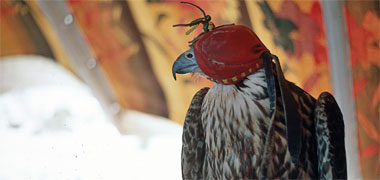

Falconry can be an expensive sport to pursue with the birds costing anything from a few hundred dollars to well over a hundred thousand dollars for a special falcon. Having said that it is not just a sport for the rich and a number of less expensive hawks can be seen with their handlers in the desert and they often accompanying Qataris on camping trips as did this hawk sitting hooded in the cool interior of a tent. But it must always be anticipated that birds will be lost, either through illness or injury or just through their not returning – it is not uncommon to see falcons flying free with their sbuwq trailing below them. The bond between falconer and hawk is important to develop because of this, and it is good to see birds relatively relaxed and comfortable enough to preen themselves as the hawk in the lower photograph is doing.
It is common to find birds sitting inside people’s houses, perhaps with a saluqi or two lying nearby, or to spot them in the back of cars being driven for viewing and potential sale. It used to be relatively common to see a row of birds on poles across the back of cars being taken between potential clients. It was fascinating to catch a glimpse of a row of small heads in the back of an expensive car as they were driven around in comfort.
The saluqi
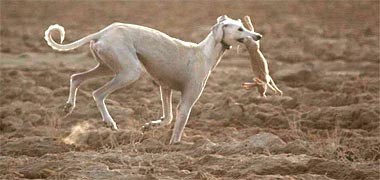
The saluqi is a beautiful dog and appears to be ideally suited to hunting and, like the camel, to life in the desert. Sulqan have been used for thousands or year and are valued for their breeding in a similar way to that of shaheen and Arabian horses. Their training begins at about three months when they are exercised and trained to accept a fairly hard diet because, in traditional desert life, they are expected to eat anything that comes along due to the lack of availability of a regular diet. They are not made pets of as are dogs in the West, though there is considerable affection for them, particularly by children. But the real love of sulqan are running and hunting, traditionally for ghazaal but nowadays mostly for the arnab or desert hare. Here a saluqi begins to slow down having just caught an arnab. A little more has been written about the treatment of salaq on the next page.
Fishing

One of the simplest methods of fishing in the Gulf has been the cast net, here photographed in October 1973 in the east bay at Doha. Where there is a relatively plentiful supply of fish, and the fisherman can see them, the net, its edges weighted, can be cast to fall and enclose a diameter of around three metres, enabling this fisherman to trap and catch any fish trapped in it, tucking the caught fish into a bag tied to his waist. It is effective and can supply a family relatively easily. However, larger communities need different systems to supply them.

Here is a typical sight in the old fishing villages. Taken at al-Ruwais in September 1972 the photograph shows a pair of fishing boats sitting on the sea bed with, in the foreground, nets stacked and awaiting use. The ones right centre appear to be cast nets but it is not uncommon to see the larger nets used on the fishing boats drying, either on horizontal posts or just laid out on the foreshore.

The storing of nets was a common sight in the fishing villages all over the peninsula. Not only did the villages depend to a great extent upon fishing, but this was also a major activity in the main town, Doha, while the rate of urbanisation within the peninsula increased. In this photograph, taken in October 1972, nets are stacked on their poles in feriq al-Salata, while the port can be seen behind the broken down walls of the old housing which had been taken over by expatriates working as fishermen. Note the polystyrene floats on the nets.
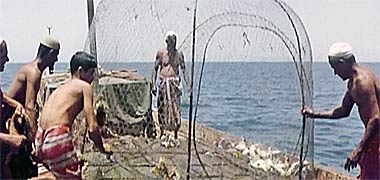

Taken in the early or mid 1960s, this photograph illustrates one of the woven metal traps, gharghuwr, used to catch fish in the deeper waters of the Gulf. Let down onto the sea bed with a float to mark their positions, the traps were lifted out onto the boat deck and – here, the relatively small catch – retrieved. The practice continues to this day as it is a relatively effective way of harvesting fish. In the past it is probable that the traps would have been woven of palm fronds or ’arish which suggests they would have had a life limited to a single season.
In the lower photograph the trap appears to have been left in shallow water as a steel reinforcing bar, seen on the left, has been used to tether the trap to the sea bed which would have made it difficult to raise. In this case, the trap is a more sophisticated form of the traditional trap round around the coast.


Traditionally fish were caught using a relatively simple, passive method which relied on channelling fish into pools from which it was difficult for them to escape. This photograph, taken in 1972, shows a typical system of traps in the north of the peninsula, formed of faruwsh with the occasional use of hasa from the nearby desert. The benefit of this system was its permanence though it required considerable labour to move the stones into place.
The lower of this pair of photographs was taken in 1972 near al-Dhakhira and illustrates the character of one of the channels funnelling down from the open sea on the left of the photograph into the lagoons where the fish will be trapped on the right. The benefit of this form of fishing is that it requires no boat in carrying out the day-to-day activity of fishing. There is no great distance to travel, and access can be made by wading through the shallow waters.


In some areas of the peninsula a different system evolved. The principle of trapping fish was the same but, instead of using faruwsh or hasa, ’arish constructions were developed, with the palm fronds held vertically in the sea bed with twisted hemp rope holding them apart to allow small fish to escape while containing the larger ones. The stone traps seen above were different from the ’arish traps in that the latter were smaller and not continuous. In these two photographs you can see a typical arrangement with a funnel created, wider at the shore side, channelling fish into a containing trap at the deeper, sea end. At that point an area around three metres in diameter acted as a container which could be closed off with a piece of sacking, and the fish sieved out with woven baskets.

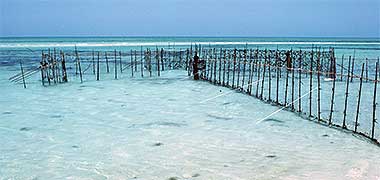
It was not long before many parts of the peninsula saw a retreat from the ’arish constructions which were labour intensive to construct and had a limited life. Steel wire mesh was hand woven and, although more expensive, enabled the setting out of the trap to be made more quickly. The first of these two photographs was taken on the north-east coast of the peninsula in June 1972 and shows a funnel system projecting some way from the shore and constructed of mesh. Fishermen can be seen working on mending or replacing parts of the trap. In the lower photograph, taken at al-Dhakhira in June 1980, the trap is organised much closer to shore and uses vertical poles stabilised with diagonal tensioning wires and vertical mesh panels.

A feature of the Qatar coastline has, for centuries, been its fishing craft either sitting on the foreshore pulled up for repair and maintenance, or sitting out in deeper water as these boats are, photographed at Wakra. They are mainly shuw’i and look to me as if they are all fishing boats except for the boat on the far left which is used for recreation as can be seen by the construction of her superstructure which incorporates a platform covering the rear half of her, and which is where family and friends can sit out and enjoy the views and activities while also providing shade for those on deck.



Fishing has been one of the main occupations of Qataris for centuries. Children fished with lines from the shore, while their fathers went to sea in boats, using nets and gharagheer like these sitting on the stern of a shuw’i at sunset. They are a common sight adjacent to the jetties with fishermen mending or making them. In the lower photograph a line of coloured nylon nets have been draped over railings on the Corniche to dry before being inspected and holes mended. Again it used to be a common sight to see fishermen sitting on the pavement mending their nets or, as is the case with the lowest of these three photos, making and repairing the wire fish traps that are a constant feature on the sterns of shwa’i. The making and mending of nets and traps are a constant occupation.
Fishing is still an important occupation, but is much enjoyed as relaxation by a number of Qataris, mainly by those not of badu origin. Generally lines are thrown from the boats when on leisure cruises and, with the large amount of fish in the Gulf, the lines seem to be a successful way of catching fish. A small number of Qataris also like spear fishing with snorkel and flippers.
It is also a notable feature of the Corniche that fishing with rod and line seems to attract a number of fishermen and, as I have seen, women fishing. I don’t know which fish are suited to this land-based sport, but it appears to be popular, though not to Qataris to whom there might be a social stigma attached unless they are of fisherman stock.
Hunting
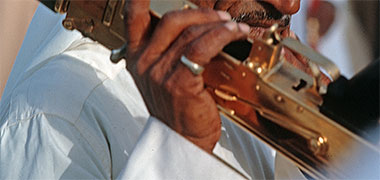
Hunting with guns is very popular with those who can afford it. Many own guns and I have seen beautiful collections of matched weapons. Here a badawi dances at a razeef holding a rifle whose metal parts have been covered in gold. The main use for guns now is for taking into the desert, perhaps as a reflection of their being carried in the past – as an item of dress, a reflection of manhood and, of course, potentially necessary protection.

Bearing guns is an ancient badu tradition though the ancient flintlocks have now been superseded by more modern rifles and semi-automatic weapons. Essentially hunting in the Qatar desert is no more than target shooting, but there are occasional formal shotgun events with Arabs doing extremely well in international events. Hunting is now carried out in countries such as Pakistan, Iran and north Africa on organised trips. The groups that go can be quite large and it is an expensive sport.
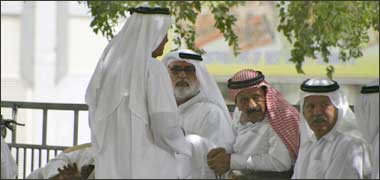
The immediate foregoing are obviously active pursuits, but it is worth repeating what I have written about elsewhere. One very strong tradition of desert life is the majlis in its various forms. Here is, in effect, a very informal version of the majlis with a small group of men relaxing and discussing matters of the day. These discussions take place for men both in their own majaalis as well as in cafés, in offices, on the beach and in the desert. This is the mechanism that passes on news, discusses issues, forms attitudes and is the single most important device in the social networking that draws Qataris together.
Horses
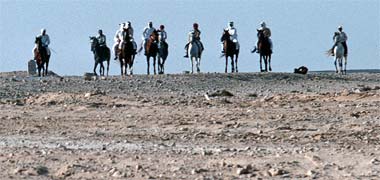
There is much to be written about horses and their connection with the peninsula, but I will just make a brief note here and perhaps come back to it later. Horses are one of the great loves of Arabs and are the subject of much prose and poetry, written and sung. In the West we are very much aware of Gulf Arabs and their horse breeding and racing interests. Elsewhere I have written of the bond between man and horse, particularly with regard to generosity. This bond goes deep and is one of the associations with the badu that are understood to be the backbone of this part of the world and its society.

It was a really enjoyable day when I took these two photographs of a group of young Qataris. They had taken their horses into the desert both to exercise them but also to feel, for a part of the day, the bond that exists when moving together through their desert. There is a strong collective memory relating to their history within the peninsula as well as a deep attachment to the horse. It requires only a saluqi or two running beside them and, perhaps a hawk on a wrist, to make the scene complete.

Qataris love horses, though not a lot are able to own them, probably because of the cost of keeping them stabled. Nevertheless, a number of private stables have been established in the country and both Qataris and expatriates exercise the horses regularly. Qataris commonly take their horses out into the desert, particularly when there is a social event at which to be seen. The presence of horsemen always adds to the event, creating a more traditional feeling. In addition to the casual and regular use of horses, a number of Gulf owners have brought their horses to a much wider public through the medium of racing. Bear in mind that it is the Arabian horse that has been the foundation of Western racing with all English thoroughbreds being descended from three horses introduced to Britain in the eighteenth century.
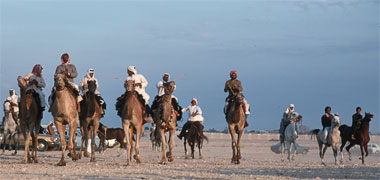
Arabian horses have been famous for thousands of years. They have moved out of the Middle East all over the world following the paths of trade and conquest in the first instance and, latterly, being bought and sold in order to improve blood lines. Although we tend to think of the badawi as being associated with camels, the latter, along with the donkey, were used for porterage as well as, in the case of the camel, also providing much of the requirements of day to day living. But it was the horse that the badawi used for mobility and warfare. Fast and manoeuvrable with endurance and intelligence the Arabian horse has always been popular, and it is these qualities which have been sought by others and expanded its presence throughout the world.
The camel
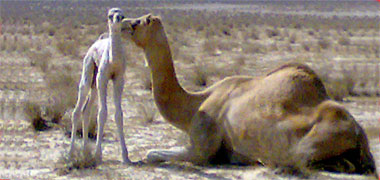
Both horses and camels are well thought of and respected by Arabs, each having its distinctive place in the traditions of the Arab world. While the Arab horse has a strong historical tradition, particularly in its association with war and the need for swift movement, it is now very much connected in the minds of the West with its breeding programmes and racing in the many racecourses around the world.
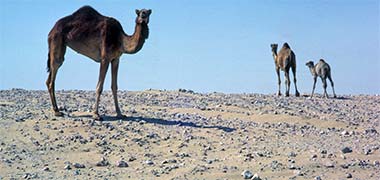

By contrast, the camel has had a more prosaic history as a beast of burden and provider of food and drink to its owners. In the West it tends to be thought of as an unattractive animal, even a bit of a joke – one such characterisation suggesting that it is a horse designed by committee. But it is definitely neither. The camel is beautifully adapted to its environment and, to those who know and work with them, an attractive and valuable animal. In some parts of the Arabian peninsula there are extremely valuable herds of camels, often white, that are cosseted and prized by their owners. Even the less valuable herds are well looked after, with many of them owned just for the sake of their heritage and relationship with the past, and the pleasure that link gives their owners.

As you might expect, although it appears not to be generally understood in the West, there are many types of camels. They are bred for a variety of tasks ranging from the more traditional porterage to racing as well as for the character of meats and milk they produce. Even today they are an extremely valuable resource to those who own and use them, a traditional way of measuring the wealth of a person or tribe as well as valuing the worth of a bride.
It might be thought that they are looked after so carefully because of the considerable investment they represent. But there remains a genuine connection between camels and their owners, particularly by the badu who look after them, even at this remove from the traditional patterns of life in the peninsula, and they remain conceptually an essential element connecting the present with the past.
There is more to be learned about the importance of camels, particularly with regard to their use by the badu in raiding, in an article originally published in 1965.

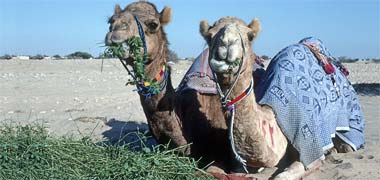
As the tribes move into and out of the peninsula it is not uncommon to come across them within the interior either moving at speed as seen in the photograph below or, as in these two photographs, resting and with the camels being fed and watered. Here, photographed at a temporary badu camp in 1988, are some camels being given water from bowls by their badu owners in the absence of a bi’r in the first photograph and, in the lower photograph, chewing one of the staple feeds of jet, used also for goats and sheep. Camels are hardy animals but now require constant attention and a diet of balanced feeds, salt lick and medicines in order to keep them in their best condition. Interestingly the medical treatments are both modern as well as traditional, keeping alive some of the values and practices of the past, despite the use of specialist veterinarians.

This is a more general view of the badu camp in which the above two photographs were taken. It illustrates something of the character of the temporary arrangements associated with movement in the peninsula. The camels are resting but will be hobbled in order to stop them straying too far should they decide to look for a more natural food than the jet being provided to them.


More often than not the badu will hobble their camels with a short length of coir rope tied between their front or rear legs allowing them to roam in their search for natural food while not straying too far from their encampment. This method has the advantage of allowing the camels a certain degree of freedom in searching the ground for their natural food, but has the significant disadvantage that they still have to be brought together at some time, usually in the evenings. I have heard that camels will tend to return of their own volition, but I wouldn’t like to state this authoritatively, and I have seen both women and men walking to gather their scattered animals. Incidentally, note in these two photographs the small amount of food there is to be taken from this part of the desert, the reason for camels needing to range over a considerable distance for natural forage.
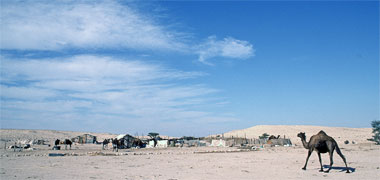
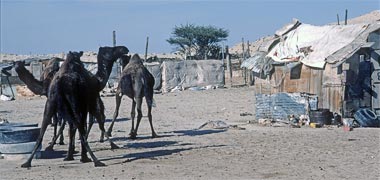
The photograph above of a badu encampment may look something like the traditional or romantic view we have of these temporary settlements in the desert, but they are not always found tented like this. In some cases advantage is taken of the availability of different materials, particularly the availability of the steel from oil drums, in order to produce a slightly more permanent camp, such as the one illustrated here with its barasti construction and animal enclosure, the photograph being taken at al-Qala’il. It is likely that this camp would have been constructed as a semi-permanent camp near a source of water and forage for the camels. It would have lasted the season before the badu and their animals moved out of the peninsula, returning to Saudi Arabia.


This ownership of camels has always been associated with the different tribes and their movement in and out of the peninsula, as well as within it. They are a necessity for the mobile tribes or families even though motor vehicles are used nowadays for porterage as well as visits for provisions and business in urban areas. With national boundaries a political reality, it might be thought these movements would have stopped, but the histories of the families with their complex relationships serve to maintain a certain porosity of borders as the strength of families remains a political reality. In this sense, the camel is a powerful factor in the continuity of traditions. In the first of these two photographs, taken in 1972, a herd is being driven up the peninsula well away from the road system. Accompanied by a pair of badawi they were moving at speed. In the lower photograph, taken in 1987, a smaller herd is being moved across the peninsula, this time accompanied by badu in a truck.
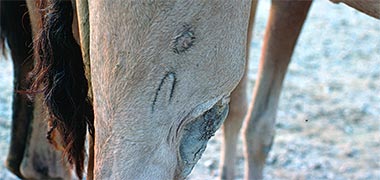

While traditional uses may not be the main rationale for the continuing use of camels, nevertheless this particular animal forms a strong bond with the psyche of modern Arabs most obviously, of course, with those of a badu stock. In this sense, the camel is also a strong component in the peninsular concept of nationhood. Camels belonging to the different tribes continue to be a feature of the peninsula and it is not uncommon to see them on the move as in the first of the two photographs above where members of a tribe were seen bringing their animals out of Saudi Arabia and into the north of the peninsula. These two photographs are close-ups of the right hind legs of two camels showing the brand of the tribe to which they belong. I used to know which they were, but I’m sorry to say that I’ve since forgotten, though the upper one may have belonged to the Na’im…
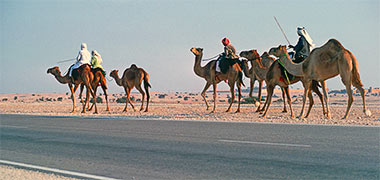
Traditionally, the camel has been used in warfare, particularly with its ability to travel easily over long distances, however Arabs generally preferred the horse for attacks and skirmishes due to its speed and better ability to change direction rapidly, reserving the camel for strategic movement and porterage. There are stories of its being used as a platform for warriors using spears but its lack of maneuvrability counted against it. I have also read of the use of camels for making long distance raids, the riders changing to horses for the final leg of the battle. The first photograph illustrates a relatively normal use of camels to move around the peninsula, this time the riders moving beside the North Road.

It used to be common to see camels in and around towns, in fact there was a camel market at the east end of Doha’s central suq with a constant turnover of these animals being brought into and out of the centre along the road system, mixing with the traffic. In this first photograph a number of camels are being led east in front of Government House, the camel market being situated just to the south of this point, and opposite the old central Post Office.
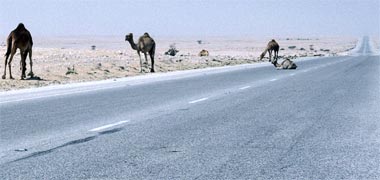
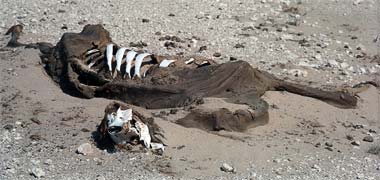
While camels are occasionally still seen in towns, this now tends to be a function relating to newly developed touristic policies rather than a continuation of the need to buy and sell them. This exercise is carried out elsewhere, and is no longer an element of a traditional mixed central market. It is still possible to come across them near roads but generally considerable effort goes into keeping them away from vehicular traffic. Many of the photographs on these pages were taken over a generation ago, and this first photograph is no exception, illustrating a general lack of concern animals have for modern traffic routes. Bear in mind that the modern road system in Qatar now comprises considerably wider road systems than is shown in the first photograph.
Understandably, camels don’t mix well with modern traffic, particularly fast moving vehicles, and it was not unusual to come across the occasional evidence of this conflict with modern traffic beside the roads as the lower of the above photographs bears testament. Again, this photograph was taken forty years ago and attitudes are now different towards the safety of camels. This was a dangerous conflict as the centre of gravity of camels is relatively high and, when struck, tended to come down on the vehicle’s cab, accounting for a number of hospital casualties, and worse.

With the development of a modern infrastructure, the peninsula now has road systems distributing traffic around it, necessitating the safeguarding of camels which remain a valuable commodity as well as a significant link with the history of both the Qatar and Arabian peninsulas. The systems are wide and there are significant volumes of traffic using them, day and night. Whether or not a sign is needed is debatable as those that need to know about the underpasses will do so. Interestingly, I believe the Arabic word on the sign for the underpass might normally be translated as a passage or path with no suggestion of it being an underpass or tunnel.
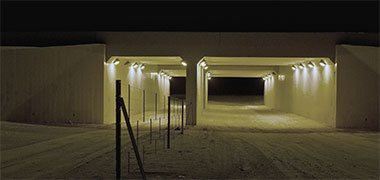
Because of the potential for conflict between vehicles and animals the State has developed underpasses in a number of locations to enable camels, together with their keepers, to move safely below them. Of course, other animals also use them and the underpasses have been adequately sized to take accompanying vehicles. It is interesting to see how the traditional routes for badu and their animals are now provided for, compared with the more random system which operated historically, and glimpsed above. It is also likely, of course, that wildlife will be able to use the underpasses.
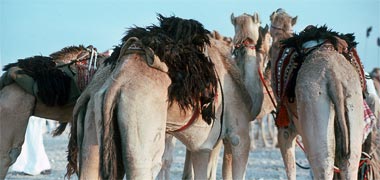
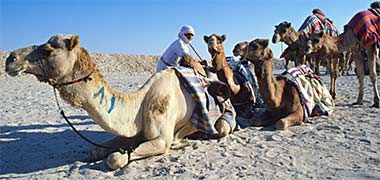
Essentially, the camel has always been a beast of burden. Its great strength combined with its ability to walk long distances have made it an ideal transporter of people and goods. The camel walks at a relatively slow but steady pace – about four kilometres an hour – and can carry up to around two hundred kilograms over long distances, twice that over short distances. Although harnesses enabling it to draw wheeled trailers have been used outside the Middle East, this never materialised in the region which limited it to carrying goods and people directly on its back and, in some areas, to being used to plough the land. The first of these two photographs illustrates the normal saddling the local badu tend to use for their day-to-day riding. The second shows a group of racing camels resting and just covered with light cloths and their racing saddles. A little more of them can be seen on this aspect further down the page.
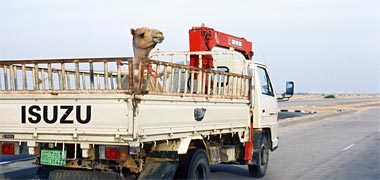

But the ability to carry loads was bolstered by the camel’s capability, compared with other beasts of burden, in moving over a variety of terrains, particularly sand. One of the advantages this had was that camels might move where there were no roads; conversely, it also meant that there was no need to build roads, a potential drawback to development. Roads constructed by the Romans and Phoenicians were, in fact, widely abandoned in the Middle East due to the camel being less expensive to operate than ox-carts, their nearest rival. These characteristics were buttressed by its ability to graze on relatively sparse desert plants, and to go without water for a number of days. Nowadays, as can be seen from these photographs of a camel being transported and, in the lower photograph, hoisted after a desert race, things can be a little different.


Some of the photographs placed above, together with this pair, were taken at meetings in the desert organised to celebrate a variety of national events. In many ways these events form a useful if not vital function of bringing together wider badu groups who might not usually meet with the same regularity. In a political sense, it has the additional advantage of enabling them to demonstrate their allegiances. In the first photograph a group of riders sit and talk exchanging views and bringing themselves up to date with family news. It illustrates what was, until relatively recently, a common sight for those moving around and living in the peninsula. In the lower photograph some badu are taking the opportunity to sell many of the essential and smaller items needed to ease life in the desert.
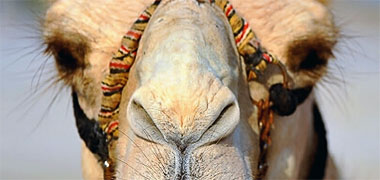
While the camel has the ability to subsist on a meagre diet of desert plants and low water intake, this diet has an effect on the milk fat and protein content, as well as the milk’s taste, though shortage of water does not unduly affect the production of milk, increasing its usefulness compared with other animals. The digestive system of the camel enables it to store energy in the fat of its hump, allowing it to go without food and water for long periods. This capability relies on its having a low turnover of water within its system compared with other animals. It also is relatively tolerant of high temperatures and its eyes have developed a double system of lashes to reduce sand irritating them, and its nose – which is extremely sensitive – has the ability to close for the same reason.
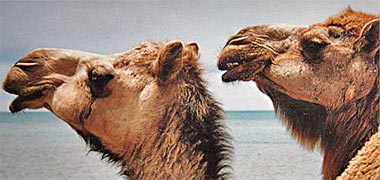
There is much to be found on the subject of camels if you search around. The older descriptions of early writers are particularly interesting with regard to the relationships between camels and owners, as well as on the size of herds and the changes brought about by increasing wealth and urbanisation. There is a dichotomy created by a general wish of governments to settle the badu, and their history which emphasises mobility and independence, the latter relating to both personal and tribal loyalties. This is looked at elsewhere.
In these notes there is a little more written about camels, mainly in the areas of sport and racing, on the previous page. The camel saddle may also be of interest due to its social and traditional design aspects. There are some notes regarding it on one of the Gulf architecture pages.
The hawdaj


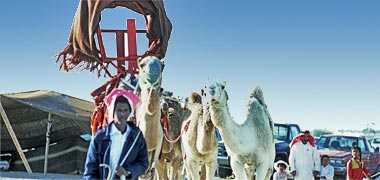
The next group of photographs illustrate a far less common type of saddling for camels, a device which is rarely seen now outside museums and certain public events, though still a necessity for travelling badu families who choose not to use motor transport. In fact, the first three photographs are of the only examples I have seen outside a museum or private house, and are of a hawdaj, the traditional way for housing badu women and children needing to travel in some degree of comfort.
The device is usually constructed from bent canes, in this case painted a bright red which appears to be their traditional colouring as it is the only colour I have seen used. The canes are bound together in order to create a framework upon which can be draped rugs in order to create a degree of effective shade and privacy for the woman and, perhaps, their youngest children, riding inside. It is also possible to carry young or sick animals and the like, giving them a degree of protection during the travel. These first three photographs were taken at two different events, held on the Corniche in the nineteen-seventies, and show the hawdaj from the side, in the second photograph, from an elevated position and behind it, and from the front in the third photograph.
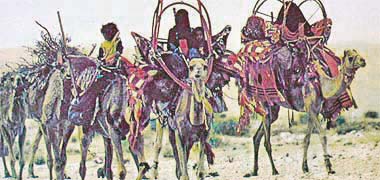
This next photograph, taken from an early Qatar government publication, shows a group of camels travelling, two of them bearing the wider framework of the full, but uncovered hawdaj, which creates more space for the two women – one of whom is carrying a small child – who are riding inside them. At this scale the hawdaj can carry a small range of items some of which can be used or worked on by the women as they travel. It appears that this government photograph was taken from the film from which I made the following images.
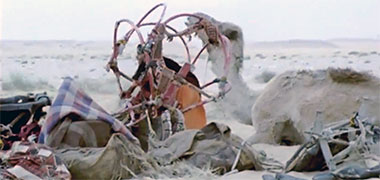
These next four photographs were taken as stills from an old video, made in 1975, and are used here in order to show a little more of the character of the hawdaj when being used by families. The first image shows the hawdaj and accompanying accoutrements – saddle, frame, padding, blankets, kelim and bindings – on the ground with two women, perhaps a wife and daughter, beginning the process of assembling it prior to lifting it onto the camel.


Most people are aware of the way in which riders usually sit on a camel, so it is surprising how much space can be created on top of the camel when the need arises. The hawdaj has a covering for privacy and protection from the elements, but the outriding elements, covered and held by a kelim create a space that appears to double the covered area. These second and third images give an indication of the substantial platform created on the camel which seats a passenger along with, in this case, two young children also to be accommodated. In the third photograph the second of the two children is about to be lifted up while his sister stands watching. A second camel waits with its hawdaj fitted with, on the left another camel carrying what appears to be firewood or feed for the camels, and a pair of young camels on the right, harnessed but not loaded.

In this photograph the family are moving away, the family and some of their requirements carried by the camels. The hawdaj has not been covered as there is apparently neither the need for privacy or protection from the weather, and the young daughter is riding by herself on the second camel without its hawdaj fitted. This must have been a familiar and common sight in the desert as the badu families moved from site to site, usually following the availability of grazing for the camels and goats. There is an image of badu moving their herd on another page of these notes which, while there is no hawdaj, gives an indication of this activity. My abiding memory of it is that the movement was rapid.
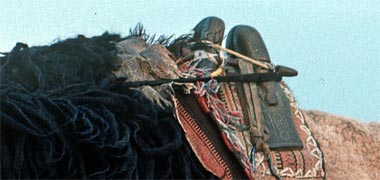
This is not an element of the hawdaj, but it might make sense to include an example of it here. The photograph illustrates part of the wooden construction bound to the camel enabling a rider to have a firm seating. This example is known as thuluwf, a pair of timbers joined together with a pair of masaleeb bound to them with cord or leather thongs forming a shadaad or shidaad – I’m unsure of the correct spelling – or hawlaani, of which more has been written about them here.
Leisure and recreation
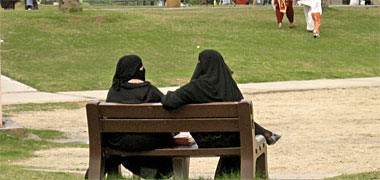
Increased wealth has changed life dramatically for Qataris. It has brought considerably more opportunities for both leisure and recreation in Qatar, and this seems to be particularly true for women. Here two young women sit in one of the new public parks and talk as their children play. It is a scene that is commonplace in the West but vividly illustrates one of the major advances that have been made through emancipation in the Gulf. As I have touched on here and here there are a number of factors militating against emancipation, but women in Qatar have benefited from a series of policies and educational opportunities promoted by the previous Ruler, Sheikh Hamad bin Khalifa and his wife, Sheikha Mosa, and this has provided additional opportunities for leisure and its enjoyment.
There will be continuing debate on how much freedom in Western terms will be allowed women, but their ability to enjoy leisure is very much bound up with the ability for men to enjoy not just leisure, but the character of leisure promoted by the many Western influences which, in many respects, are in conflict with Islamic values.

Prior to the 1970s, boys and young men were able to take advantage of clubs in the different badu where they would be able to play board games and some ball games. They differed in character but were not always looked upon favourably by some families. There was no comparable facility for girls and women. These clubs expanded considerably with increased wealth and now have a very different character and range of activities open to their members.
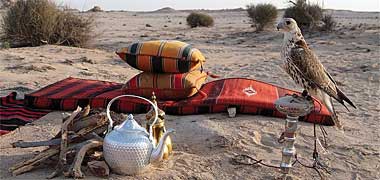
But, for men, there is an area which I have placed here under the notes on leisure, which represents so much more than leisure. In essence, it is the desert. This photograph illustrates the basic requirements for a leisurely stay in the desert. It epitomises the lure that the desert holds for many Qataris, whether of badu descent or not, but particularly for the former with their love of hunting with falcons. It may be difficult to understand unless it has been experienced, but the desert is not just a setting for modern leisure pursuits; it is a connection to history and tradition, a continuation of a way of life which is so different from the modern way of life that, nowadays, it has to be experienced as a specific exercise.
In moving into the desert, worries drop away and Qataris can be seen to relax visibly. Although this can be thought of as leisure in that it is certainly not work, it really represents the reclaiming of a traditional way of life. The above photograph illustrates both the passive and active elements of this form of leisure: the passive is represented by the dowshek and masaanid together with the fire, ibriq and della, while the shaheen represents the active sport of hunting. In this setting many Qataris feel at their most natural. Leaving the worries of work and business back in their urban environment, this might be thought to be a form of escapism. If it is, it also reflects a firm understanding of a more natural way of living where it is possible to meet friends in an informal majlis setting within a natural environment. Desert life was harsh and spending time out of the modern, urban environment can not fully replicate its range of activities, but it is good to see that it is, nevertheless, pursued even if this is considered to be a leisure pursuit.


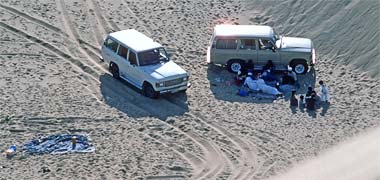
The desert is not just a place which attracts men; families are also drawn to it, particularly at those times of the year when the fuq’a can be found there. Here, and in this photograph above there are views of typical expeditions to the desert in search of this seasonal delicacy. The whole of the family participate and this has been a traditional way for enjoying the land in which they live and to which they attribute such great importance, particularly those of badu stock.
But it is not just the search for desert food that has attracted families; as can be seen in these two photographs, families also enjoy the sand dunes which begin south-west of al-Wukair. Although it may seem obvious to Westerners, time spent where both male and females of the family are able to relax together, is important. This is a society where considerable time is spent with the sexes separated, traditionally fulfilling other socio-cultural requirements – though this may be changing with the massive influence of Western societies. I should also mention that families also go to the sea, but I have no strong recollection of families camping beside the sea to the extent they do in many parts of the West.

Yet the sea does provide an attraction for Qataris, even those whose heritage is in one of the badu tribes, as shown in this photograph where a group of young Qataris are establishing their camp where they will be able to enjoy time in the north of the country as they said, away from the pressures of the city. Bear in mind this photograph was taken in 1972 when Doha was nothing like as urbanised as it is now. There are obvious benefits about camping beside the sea and this group brought with them a number of items to enable them to enjoy a range of traditional desert activities including hawks and a small plastic boat so they would be able to fish. In the event this latter was not needed as fishermen came by and sold them fish. They were also able to obtain camel milk from badu who were either passing or camping nearby. In many ways, this was the ideal way to experience life in the peninsula. Bearing in mind that the camp was miles from anywhere and that in those days there were no mobiles, it was surprising how many contacts were made and how much news was learned.
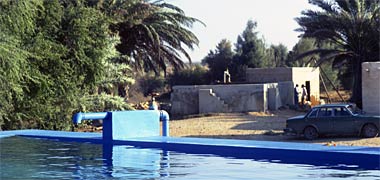
However, it is not just in the desert that Qataris can relax and feel at home. Those that have farms have always used them to visit at weekends or for longer periods of time, drawing on the dramatic contrast that exists between the luxuriant planting in farms and the desert immediately outside them. Traditionally, water that is abstracted from the ground water table has been used to fill header water tanks at ground level from which irrigation water is distributed around the farm to water the plants. Those tanks are used for swimming and a way of keeping cool, with time becoming enlarged to provide a more important resource for those wanting to cool themselves or enjoy a swim while still retaining their irrigation function.
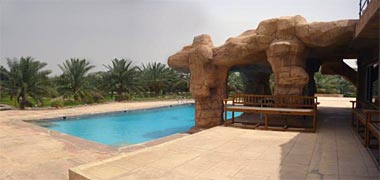
More recently these facilities on farms have been more significantly developed in order to provide a wider benefit to the family, friends and guests. In this photograph note the regular planting of date palms that will eventually bring shade to the poolside area. It is also notable that a number of traditional wooden dikkaat have been provided in the shaded area between the building, the water slide and the pool.
Inside the farms Qataris are isolated not only from the general environmental pressures that exist in the peninsula, but also from the ubiquitous foreign presence that exists outside them. Farms are true havens of peace and calm which points towards the desire of those with villas to plant them heavily in order to take not just physiological but also psychological benefit.
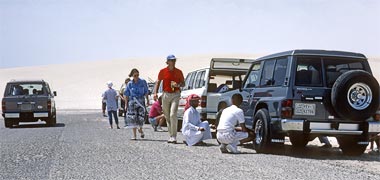
While some Qatari families are able to take advantage of family farms in the peninsula, there is also the wider desert to be enjoyed, particularly by the large number of expatriates with time on their hands at weekends, and who want to experience something of the desert. Regrettably the peninsula is not large and does not have the variety of One such area of the peninsula enjoyed by expatriates as well as nationals is the sand dunes found south of Umm Said – now renamed Mesaeed – and the related marine inlet of Khor al-Udeid.
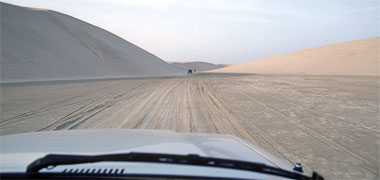
In the first photograph above, a group of expatriates and Qataris can be seen at the last point of the road preparing for access to the dunes. At this point there were a small number of retail outlets where those who had forgotten to bring essential supplies, wanted refreshments or, importantly, needed their vehicles and tyres checked, could do so. One of the most crucial actions to take at this point was for drivers to let down their tyres in order to enable the vehicles to spread their loads better in the soft sand.

These three photographs show something of the first part of a trip into the dunes with this group making their way down to Khor al-Udeid to spend the day beside the sea and enjoy a barbecue. In the seventies and eighties this was a pleasant excursion when there would be few people making the trip and only the occasional group or police patrol being met along the way or camping.

Part of the excitement of these forays into the dunes was the sense of adventure for those who spent their time in offices or the comfort of their homes. There was always the prospect of being stuck in the sand, a fairly common occurrence, particularly for expatriates without the knowledge enjoyed by Qataris. Here, in November 1979, two four-wheel drives are stuck at the top of a dune as they attempted to avoid a crash – it is usually impossible to know what is on the other side of a ridge…
But with the increasing number of expatriates wanting an outlet for their energies, and the government wanting to expand its tourism opportunities, a small hotel was opened and the concept of getting away from the city became a more managed operation. Certainly it is a good idea to go with a group in case anybody gets into trouble, but the safeties implicit in the commercialisation of the dunes has not been to everybody’s liking. Having said that, there are many who do enjoy increased access to the dunes, though it is thought that their ecosystem will suffer from the dramatically increased numbers and character of traffic.
More to be written…
Children’s recreation

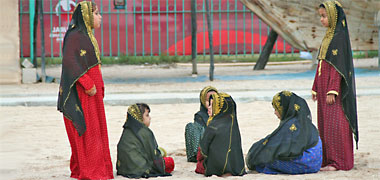
Children’s play has changed dramatically in the Gulf, as it has in the West over the last generation. Up to the nineteen-eighties it was common to see many of the traditional games being played in the street, or in the desert or beach where families would travel at the weekend to relax and enjoy themselves. Those games used relatively simple objects, often found, as children have done all over the world. But this is no longer the case when increased wealth and pressures, in the main from television, advertising and travel, have introduced novel and, often, more formal characters of play. These two photos of two boys playing marbles and girls engaged in a traditional game are relatively unusual and were, in fact, taken in re-enactments which have become a feature of the tourist industry in Qatar. They illustrate what was a relatively normal sight.

I have written above about the ages at which girls and boys stop playing together. There is no hard and fast rule but this photograph is interesting in that it shows young girls chasing the younger boy with the older boy looking on. The older boy is obviously of an age when it might not be thought seemly for him to join in, so he takes more of a passive role while still enjoying being with his brothers and sisters or cousins. At this age he will have been accompanying his father to majaalis for some time, and will also be used to giving orders to his younger siblings, particularly the girls, acting in loco parentis. It is good to see children playing out on the street in this day and age.
Leisure is the term that encompasses activities of various forms, some of them recreational. It is the recreational activities that I am particularly interested in here. ‘Leisure’ and ‘recreation’ are not interchangeable terms.
Play or recreation has two main types:
- active, and
- passive.
Active recreation
Active recreation requires participation and implies the expenditure of energy. It is usally assumed to encompass sports, whether team or individual. But activities can range from low-impact activities such as yoga and walking to high-impact activities such as squash and football. These latter activities include contact sports such as rugby and judo – neither of which I have seen Qataris taking part in – as well as non-contact such as track and field sports, swimming, wind-surfing and the like.
Passive recreation
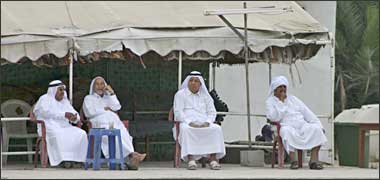
Passive recreation, on the other hand, implies either the lack of intent to participate in an active pursuit, or the casual viewing of an activity that interests the viewer. It involves no or little expenditure of energy and tends to be observational such as watching football, viewing art works, reading or watching television. It can be thought of as unproductive, but there is a body of evidence that some forms can be beneficial to the individual – though not necessarily developing his or her physical health. But Western influences soon became established in the peninsula, notably the first cinemas.
Need and opportunity for play
There is a basic and natural need for children to play now as there has been for years, though there are some significant changes. Due to the lower housing densities, the numbers and character of expatriates living near Qataris, and the lack of social neighbourhood cohesion there are less children of any given age group to play together than there were twenty or more years ago unless parents transport children. As I have mentioned previously, the extended family helps to enlarge the numbers of children in contact with each other and, where this is not within a single compound, it is natural for the families to move between compounds, bringing their children with them.
Not only do many children have to be taken by their parents to play with relations and friends as their houses are not in the same proximity they once were, but also the neighbours are unlikely to be related and may not be the friends they once were. This is one element that tends to discourage the casual play that is an important element in developing the growing child, and is particularly true in housing areas that have a wide variety of nationalities living within them. Compounding this is a relatively new factor that sees far more toys – mainly of Western design – purchased for children due to increased affluence, a larger disposable income, and a national tendency to over-provide for children both toys and sweets. Qatari children have far more toys than Western children, and gifts from family and friends are, to the Western mind, over-generous.
Traditional recreation

In the past patterns of play were guided by two particular aspects of life in Qatar. Firstly, the physically small size of the conurbations with their tight internal cores and easy access to the immediate hinterland and, secondly the lack of money with which to buy, and the small amounts of scrap material from which to develop, play objects. A third, cultural, aspect was the lack of formal games in the region as had developed in the West over time, such as football, cricket, tennis and the like. Games which required expensive items were obviously not followed though, as in the West, substitute arrangements were made for playing games such as football as these games were introduced and gained popularity. In this photograph, a group of children play with an improvised football on an area of cleared land inside Doha’s inner ring.
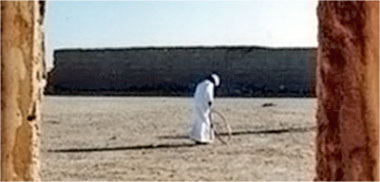
Children all over the world have traditionally played with their friends around the house and its curtilage using found or made objects for their games. In the past Qatari games were developed using simple materials that were readily to hand, often utilising discarded and found material. Their games might be classified as active or passive. Of the former there were running games such as stick and hoop as illustrated in the top photograph here, and mobile games such as hopscotch which requires only lines scratched in the sand and a stone to play.

Running games seem to be popular all over the world and, certainly in the cooler months, it was not uncommon to see boys playing with wheels of various sorts. These two photographs illustrate two variations that were played around Doha. The increase in wealth brought an increasing number of vehicles into the country which, in turn, provided a growing resource in terms of the numbers of used tyres that began to litter the country. In residential areas they formed a resource which, as can be seen in the first of these two photographs, might be used for play by both girls and boys, though I think the former unusual. They also formed markers for football and other games.

In this second photograph a boy is playing with a wheel attached to a rod, which makes it a slightly more sophisticated toy. As I recall it, this was used to chase girls with, though I would not like to think this was its only application. Running games are a means by which surplus energy is run off as children roam around their neighbourhoods. Perhaps it gives a rationale to the need to wander or even mark your territory as used to be the case in the West before perceived and actual dangers forced children to remain within the curtilage of their houses. The chase, in this case, is a bonus.

There were also competitive games such as a game that I used to know as tip-stick where a small stick on the ground is struck in such a way as to lift it into the air when it is then struck again with a view to sending it as far as possible. In Qatar the game was known as al-qleena wa al-matuwa’, and was played between two players or two teams, there being senders as illustrated in the lower photograph and receivers whose task it was to stop or catch the struck stick. This was one of number of games that developed individual hand and eye coordination, skills which included simple games such as stone throwing and marbles, but there was also model boat sailing and kite flying which required other skills in order to play successfully. In addition to these, in the littoral developments, there were games that developed with water-based skills related to swimming and fishing.
Range of games

Passive games were relatively few as even board games – in actuality played on the ground using stones as counters or markers – had a degree of active participation by onlookers taking their turn to play. But what there were appear to have been, or were variations of manqala. There is evidence, incidentally, of boards carved in the rocks at jibaal Fuwairat and Jassassiyah, that go back centuries.
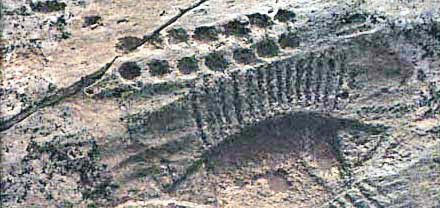
This example of double rows of carved holes is thought to have been created for the game of manqala or a similar game renamed locally as al aa’ilah or al haluwsah. Both the rock carving and double rows are believed to be centuries old and are located on jebel Fuwairat on the north-east coast of the peninsula. The theory is that they were carved by people waiting to spot the pearling fleets coming in at the end of the season. Whether for the pearling or fishing fleets or, perhaps, keeping an eye open for the British, pirates or raiders, they indicate the popularity of the game.

I am still in the process of identifying the most common games that were traditionally played. There are said to have been many and that they differed throughout the peninsula though, of course, some would have been common. It is possible that there may have been a distinction between those played in urban and rural communities, but I have not yet been able to research this. These games depended on relatively simple items that could be inexpensively sourced or fashioned, and on invention. According to the site of the Qatar Olympics Organisation, the games included al dahroi, al sabbah and taq taq taqiyyah for boys and, for girls, al kunatb, al laqfah and nat al habl.
Most games were designed to give everybody a degree of participation. These patterns have changed. Despite the emphasis on sports in School and in the various sports clubs, there is now the reinforcement through availability out of School of many passive pursuits with the consequent effects upon children. This is perceived to be a serious problem by Qataris, but is a concomitant of the way in which society has developed with increased contact with the the Arab world and the West. Nowadays active children’s games include but are not limited to – football, running hoops, shuttlecock and battledore, rope games, boats, cars and adventure games based on toys and equipment – and passive pursuits include video and television viewing, recorded stories and music, watching football, basketball, etc.
I should explain that the sports clubs were scattered through old Doha and the other towns of Qatar and were usually associated with a qabila or feriq sometimes, of course, the two being coincident. Depending on their location and funding they were of different sizes but usually consisted of a building with an associated open area. In this area football was the main activity despite their being much smaller than a football field and being covered in, usually, sand. In the building the usual activities was watching television or playing board games. The key point being that the sports clubs were a focus for local interests as well as the beginnings of competitive development. Now these clubs are of a notable size with considerable funding at their disposal.
Influence of servants
One element that I notice seems to be having an influence on play is the introduction of servants. Increased affluence has enabled many families to employ at least a maid, usually from the Philippines or Indian sub-continent. The maids help with the household chores but are often required to – or take it upon themselves to – help entertain the smaller children of the family, particularly to learn English. There appear to be three consequences to this that are not that helpful.
Firstly, the English spoken by maids is not usually that good and, as a consequence, the child in its formative years picks up poor grammar, vocabulary and pronunciation, elements of language that are difficult to improve on in later years.
Secondly, I have noticed that maids often participate in play as an unnecessary auxiliary aid. For instance, pushing a pedal-bike, directing play or insisting that television is watched. Apart from the cultural problems maids from different countries bring, their attempts to ease or direct leisure activities take away from children some of the adventure they should be involved with.
Related to this, the other consequence seems to have something to do with the maids’ attempting to keep the children happy, that is encouraging the children to eat sweets and drink canned drinks. While I can understand the wish to keep their jobs, my experience is that the children become used to having a high sugar content diet, and become spoiled knowing that they can always get their own way. This is problem in many families without maids but, at one distance removed, it is far worse and is likely to be one of the factors accounting for the degree of obesity in modern youth.
Since writing the foregoing note, which was based on my observation and experience, there has been recent confirmation of this trend in an article articulating and commenting on the results of research into the problems of obesity in women in Qatar, made in 1989, but a condition that appears to be continuing. The issue here is that the use of unqualified maids to provide childcare has a direct influence on the health of children. It is likely that expatriate maids will have limited knowledge of Arabic and less understanding of healthy dietary practices. It is noticeable that many children under the age of ten are commonly seen in Qatar’s malls and shopping centres accompanied by expatriate maids. Both here, and in the home, there is likely to be pressure on maids to cater to the desires of the children in their care with fast food, a habit which is likely to exist both within the family as well as with their peer groups. The consumption of fried foods on a regular basis will, in many cases, lead to serious chronic diseases that will include diabetes mellitus and cardiovascular diseases.
Girls’ play

From the age of around eight or nine girls are no longer able to enjoy the freedom boys have and are restricted to the house. Specifically, they are not allowed to play with boys outside their immediate family. Play for them must centre on the house and with female family or relations where they are heavily involved in learning the business of the household. There is also School where, depending upon the School, they are able to take place in organised games or activities such as gymnastics and basketball. Public display by girls or women is still forbidden though there are pressures for change. Recent years have seen a loosening of male attitudes in line with increasing Westernising of the country but there remains, and will continue to remain, serious opposition to exposure in public. This means that their ability to perform in sports is restricted mainly to educational establishments and female audiences.

This restriction is not quite as closely maintained in activities such as dance which is taught in all schools, and it is possible to see performances on television. However, it is usually only girls who are seen performing, not women. An unfortunate aspect of this, however, is that the dances taught are rarely traditionally Qatari. It is also notable that the majority of children’s songs are derived from Qatar’s marine tradition rather than from the desert as the majority of people lived in settlements on the coast, an issue which also relates to boys and their songs.

This photograph, like that above, was set up for a poster issued by the Ministry of Information, but it illustrates a very common game played by young girls. It shows four girls playing house. They sit on a manufactured carpet with a drawer or box between them in which they seem to be setting out a room occupied by a family. Father and mother sit on the left with a decorated chest to the left of them and, in the near left and right corners there are two more women. All three of these women wear the traditional batula and there is a bare-faced woman, perhaps a girl, in the top right corner. The girl top right appears to be dressing a male doll and, interestingly, has rings on her wedding finger. This scene might have been taken of any group of young girls acting out real or imagined family life.
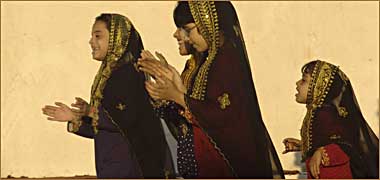
Here four girls play a game which involves singing and clapping as they move to their own rhythm. There is a strong oral tradition in the Arab world as there is in many cultures where there were few opportunities to write and pass on their histories due to the lack of the necessary materials. In this respect, these young girls are replicating a tradition which, in men, can be heard at their razeef where songs are constructed extempore but passed on between peers. They can be novel, historical, satirical or comprise a mixture of styles.
Boys’ play
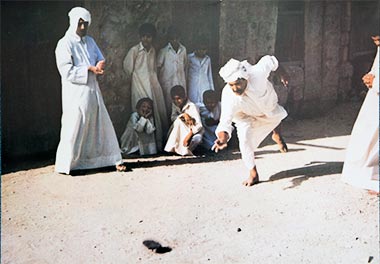
Although this photograph illustrates a note on boys’ play, it appears to show men playing marbles. Of course this is considered to be a boys’ game and I have no idea why it should be men playing it, but it was certainly a popular game for boys even in the nineteen-seventies, hence its inclusion here. There are many similar games played all round the world. They are based on the availability of simple materials or items readily to hand. Sticks and stones seem to be the most easily used, but games which became board games were also popular and can be seen carved in the rocks at Jassassiyah.
While girls of the household are encouraged to learn their roles within it, boys have a similar process designed to set them in their place in the household. To some extent this takes them away from play as a formal or informal activity as they begin to take their place in the men’s world. It is not uncommon for very young children to be taken to formal majaalis, to offices and to the shops, the latter two operations in reality an extension of the majlis system.
As a part of this system boys learn at first hand the formal and informal rules associated with the life of men within the society. I have seen that not only do they go to the masjid where their participation is a natural element of their being a member of the Muslim society but, in majaalis they both assist in the operation of the majlis as well as being brought into conversation and their advice sought. It is interesting to see how they develop, obtaining the confidence, for instance, to order and direct servants. Which reminds me that a combination of this confidence, overlying the basic relationship between the sexes, creates the unusual sight to a Westerner of young boys ordering their older sisters around – and the older sisters obeying them…
This additional feature of boys’ lives takes them away from informal play for part of their day, but it compensates both by giving them the confidence that comes through knowledge as well as permitting the wider male society the opportunity to witness and make judgements on the individual boys. This is a feature of badu society where individuals are selected for their competence, and where primogeniture is not practised.

As for the games that boys play, reference has been made at the head of this note to the traditional ways in which boys find and use found or made objects in their play. I don’t know the name of this game but believe it, or games similar to it, to be common to many parts of the world. In fact I used to play something similar as a boy. In the game I knew a boy would balance a small stick on a stone, hit one end of the stick to make it rise in the air and then strike it with a longer stick. The aim was either to see how far the smaller stick could be sent, or for other boys to attempt to catch it. If they were successful, then they would take their turn to use the longer stick. This photograph appears to illustrate that game with a boy attempting to catch a smaller stick. In real life the fielders would stand further away as the game can be a little dangerous at close distances.

This photograph, taken as were the others above from a Ministry of Information poster which I believe was distributed in the early 1980s, shows a group of boys, some of them dressed in the formal clothes of adults, and singing. As they are not standing in any of the arrangements used by singers at a razeef, ardha or tambura nor in any of the fishing arrangements, then I assume this to be a school or similar grouping. It appears to have been significant to the Ministry. While I have not seen boys singing like this, I have seen and heard them singing informally and at school. There have also been television programmes with children singing. The point here is that voices can be used readily. Whether they are used in formal play, informal entertainment or an accompaniment to play, it is not possible to say here. What is possible is that singing was used to accompany work by those at sea, perhaps more than those on land.
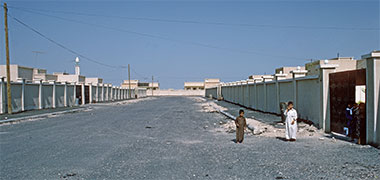
In the older parts of towns and villages, play was common within and around the curtilages of houses. The generally unmade paths and roads made it easy for children to play barefoot and create the necessary declivities, mounds and markings for the majority of their games. Some of these games were static and others had children ranging around their neighbourhood. The new developments being constructed to provide public housing very quickly had the spaces between house walls completed with tarmac for both pavement and road, as in this photograph taken at Medinat Khalifa in 1972. These external areas were not conducive to the traditional forms of play, though sites that yet to have houses built on them provided locations for informal games, such as the football shown below, as well as a resource for materials that might be used in play.
More to be written…
Sport

I have broken away from play to look at the subject of sport in order to try to look at this element of play in a wider context. I can’t say what the most popular sport in Qatar is, though I suspect it is football when looking at the resources given to it. This has much to do not only with the influence of the international cult of football, but also something to do with competition both within the country and, now, abroad as there is significant competition between different areas of the peninsula as well as the desire to be represented on the international stage.

In the first of these two photographs, taken at feriq al-Salata in a space between ruined traditional houses and new concrete block housing, an informal pitch has been created with the ubiquitous oil drums marking the goal. In the second photograph, taken at Medinat Khalifa, a football pitch has been scraped out in the corner of the new housing layout, the goal constructed of timber construction boards used in building the new development.
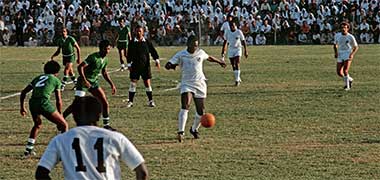
All over the peninsula informal games of football took place on spare pieces of land such as these. Children played wherever they could, but the different sports clubs were able to take advantage of increasingly improved pitches. The only grassed pitch in the early 1970s was the National Stadium in the east of Doha where a variety of events took place as well as important football matches. This was the obvious setting for special displays such as when Pelé was invited to play in 1973.
Camel racing



Arabs traditionally love camels. The camel is, despite the lack of understanding it appears to enjoy in the West, a beautiful animal well suited to it natural environment, the desert. This first illustration shows something of the excitement of camel racing; but it is not just racing that is their attraction. There is considerable tradition in the Arab world relating to the animal on which so much reliance has been placed. Both as a beast of burden as well as a source of food and shelter it has been fêted for centuries.
And they are valuable in themselves with some camels changing hands for small fortunes based not just on the standards we would associate with, say, dogs, cats and horses, but for their good looks. Nowadays good breeding and racing camels command high prices as racing has become an increasingly popular sport. In the past these races were held out in the middle of the peninsula with the owners driving their four-wheel drives alongside their camels to encourage the riders to greater effort. But times have changed.
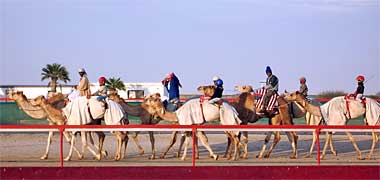
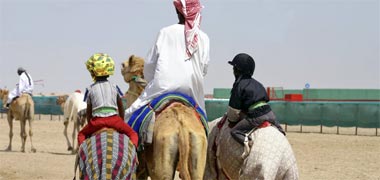
The photograph above and these two photographs show child jockeys mounted on racing camels. They were taken in the early years of the twenty-first century, but this practice has now ceased. Many in the West will have heard or read something about the problems associated with under-age jockeys being brought into the different Gulf states in order to race camels. This has been a practice for many years, though recently the climate has changed. The great benefit of having children instead of adults was, of course, the children’s relatively light weight and their individual skills. Usually these children came from the Indian sub-continent and were taught at an early age to control racing camels both in their home country as well as in the Gulf. These camels are, like race horses, highly strung and require considerable skill as well as strong control, and it was considered a tribute to these young jockeys that they were able to handle these camels effectively.

But the concern that has been expressed now seems to have been dealt with, and Qatar was the first of the Gulf states to ban the use of child jockeys and introduce automation to the racing of camels, as can be seen in these two photographs. In doing so the sport has changed considerably though not all Gulf Arabs are happy with the new system, their argument being that it is unnatural not to have a human rider on the saddle. In this there is a far stronger argument as the camel has always been tied very strongly to the life of the badu in many of their aspects and, in this respect, camel racing differs strongly from horse racing.
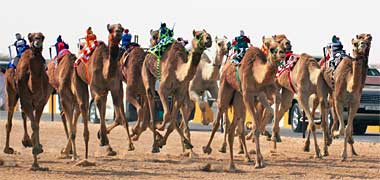
Whereas, traditionally, it was not just the camel that was being raced: the rider, generally a badawi, was also considered to be an essential part of racing. However, this argument diminished with the advent of child riders and, nowadays, this element of the race is no longer as important, and it is the camel solely that is being admired and tested. This photograph of a race at al-Shahaniyah illustrates the character of the camels in action, the mechanical jockey being a smaller visual element of the scene. What is very different from horse racing is that, when raced, the owners or trainers drive their cars alongside the camels and direct the automatons through wireless controls. In this the cars and their drivers are at risk due to the speed and proximity at which they drive; but it does make the race that more interesting for the owners…

Here is a detail of the robot jockeys which, as you can see, are curious in their interpretation of their purpose. There is an obvious attempt for them to display a head and a body, albeit both small, and there is a feature that resembles the racing cap of horse jockeys. These are the basic models onto which the owner dresses his colours, just as horse jockeys are distinguished. Out of the right arm hole is a long white whip that is used by the owners to encourage their camels to move faster.

But it would be wrong to give the impression that all racing is carried out using mechanical jockeys. Ever since the racecourse at al-Shahaniyah was introduced, there have been adult jockeys employed to race the camels. In this photograph, taken there, a jockey is dismounting his protesting camel. Those who have not seen this may be surprised at the speed with which the camel stands when it is mounted or dismounted. To mount, the camel is tapped on its knees to make it kneel and the jockey jumps on quickly, the camel immediately standing, back legs first, throwing the rider forward.
Golf

There were no sports in the Western sense enjoyed in the peninsula before Westerners introduced them. Certainly there was hawking in the region and there were games played by children which will be dealt with elsewhere, but I believe it was golf that was introduced as the first formal sport with an established set of rules. The first two courses were associated with the oil companies and were formed at Umm Said near to the oil terminal in the south of the country, and Dukhan in the west. With no grass in the desert the courses were formed on the sand with the areas around the holes oiled to stop movement of the sand and to create a relatively smooth area. To tee-off, players carried with them a small piece of artificial turf to replicate grass.
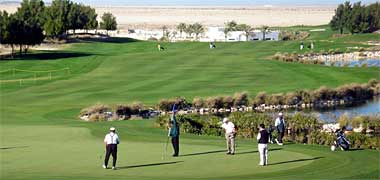
The skills developed playing on sand were different from those required on traditional, grass courses, and residents consistently were able to beat visitors unused to the novel surface. With the increased interest in tourism, buttressed by the ability to create and water grass in the peninsula, grass courses are now being introduced throughout the region, including Qatar as can be seen in the lower photograph.
Although Qataris have been known to play golf, it really remains the province of Westerners incorporating as it does a very popular sport and a device for maintaining and developing social and business contacts. In this latter context it has interesting resonances with the majlis system enjoyed by Qataris.
more to be written about:
traditional and new sports
horse and camel racing,
cricket,
baseball,
football,
basketball,
tennis,
fishing,
water sports – sailing, power boat racing, water-skiing, jet-skiing, wind surfing, swimming, snorkelling…
motor racing, motorbike racing, drag racing,
other – cycling, rugby, running etc.

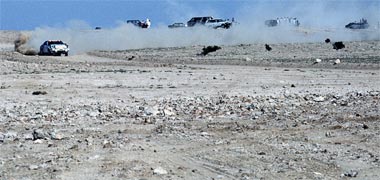
For some time Qatar, as national policy, has been encouraging a number of different sports circuits to include Qatar in their annual programmes. The policy started in the 1970s with the introduction of exhibition matches but by the 1980s other sports had been introduced. There is serious competition between the Gulf states as only one country will be able to take a single sport from each circuit. Bahrein, for instance, is now on the international Formula One racing circuit, and rallying, golf, tennis and squash are now annual events in Qatar. I have to emphasise these are spectator sports though there are some nationals making inroads into these sports such as rallying, shown here with a car speeding through the typical terrain in the centre of the peninsula.

A number of nationals took to some of these sports in their early days. One who made an early impact in his field was Saeed al-Hajri who participated in rally driving which concentrated on the central hard limestone character of the centre of the peninsula. He is seen here with his co-driver and Porche resting between stages of the 1985 Qatar Rally which I think was first held in 1983.
In many ways rallying in the desert is a natural extension of traditional movements and sport in the desert. Nationals may be thought to have a natural advantage in both their familiarity with the land and their ability to read the smallest of signs necessary for survival in the desert.
Friendship

I have called out this particular element of social contact to make only a couple of points, but ones that have struck me while living in Qatar. They are noted here as there are significant issues that may not be considered by those with a Western upbringing. The point is what you might expect – it is important to be able to understand what you see, particularly if you come from a different society.
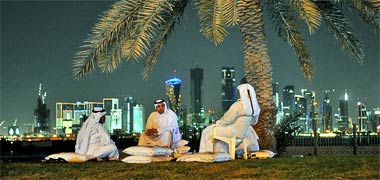
The photograph above and this to the side show Qatari friends meeting in the desert, and at night on Doha’s Corniche. They illustrate something of the traditions of the peninsula but, more importantly, something of the character of the people in their natural environments. The top photograph shows friends meeting south-west of al-Wukair and was a random encounter; the second photograph shows how a small group of friends have brought a chair and some masaanid to a grassed area of the Corniche where they can watch people pass, have friends meet and sit with them, and enjoy the pleasant Autumn evening as they sip tea. It is an informal majlis. Later they will move on to other majaalis before returning home to sleep.
Qataris are brought up within extended families and, through this system, together with their traditional location within a qabila and, by extension for many of them, a tribe, automatically have a wide range of friends from which to choose degrees of relationship. These will be Qatari friends. There may be non-Qataris living near them and with whom they might come into contact as children, perhaps through their parents and their relationships with the non-Qataris. Formal schooling brings with it the opportunity to make more friends, introducing a number of non-Qataris who would not necessarily live near them. Later, work will extend this as will education abroad, and the overwhelming numbers of foreigners temporarily living in Qatar will complicate issues more.
Having said that my observation is that most Qataris tend to make, and retain, Qatari friends and that non-Qataris rarely have the same relationship as that enjoyed between Qataris. The impression I have is that Qataris have a society that bonds them closely and that they don’t have the same interests to share with non-Qataris. Of course, there are shared interests in football, television and the like, but the business of being a Qatari is one that automatically requires diligent and continual work in order to retain status and a place in society. Friendships and acquaintanceships with non-Qataris occur and are maintained spontaneously, but they can not replace the necessity of inter-Qatari relationships.

In this photograph, for instance, two men sit comfortably and talk informally in the suq adjacent to the mosque where scribes used to sit and where miswaak, seen on the ground, were sold and shoe cleaning and mending were carried out. In a sense, this is the majlis system operating at its smallest unit, the interaction of two people. It was and, to some extent, still is the custom for men to make the rounds of shops and offices every day where they will sit, drink tea and exchange news of the day with friends. It is a leisurely process and one that has operated for centuries. It depends on trust and familiarity and is an essential element of the socio-cultural character of the region.
Qatari society is relatively small and there is a strong oral tradition which sustains a constant reinforcement of social relationships and shared attitudes. The setting for all such discussion is the traditional majlis, normally a room within a house dedicated to the meeting of men. A family room fulfils the same function for women, if there is space within the house. Every evening Qataris will visit each other, often in descending order of seniority to discuss mutual interests and affairs. To these majaalis will come Arab non-Qataris as well, though this is not the norm. Often such visits will be courtesy visits and will not last that long. Westerners will also visit, particularly if invited as guests, but it is unusual for them to follow the practise of Qataris and use the majlis system every day. Where non-Qataris participate in majaalis, the majaalis will not discuss a number of subjects that a Qatari-only majlis will discuss. Or so I’m told by Qatari friends. I have to say that it seems logical.

Those who enter the majlis are usually offered Arabic coffee. This is a cardamon flavoured drink and is served in small cups or finajil which are offered and held in the right hand and sipped, the person offering the coffee standing and waiting to refill the finjaan. It is considered impolite to have more than three cups of Arabic coffee. To indicate that no more is wanted, the cup is given back to the person serving the coffee, and shaken slightly. The next person will then be served.

Commonly the Arabic coffee is followed by a small glass cup of sweet tea without milk – shy ahmar, or red tea as it is termed in Arabic. Here is a typical glass with the plain red tea in it. The tea might have na’na in it as a pleasant change in summer. In winter the tea may be presented with zanjabil or ginger in it as well as sugar and milk, usually condensed milk. They are all very refreshing drinks.
With the development of the country and increased commercial activity, it is interesting to see that bottled water is becoming a standard drink presented in the majlis and elsewhere as a matter of course. It is also worth noting here that this bottled water, always served cold and in its plastic bottle, is a fraction of the price it is in the West.
Nowadays the traditional della is not always used in the more informal majaalis. Instead coffee and, particularly, tea are held and served from insulated flasks.
As the evening progresses there will be movement to other and less formal majaalis and discussion may give way to cards, video or other pursuits. But the importance and function of the majlis as a social setting has not altered.
It has, however, wavered. New houses tend to have sitting or living rooms in the western manner rather than traditional majaalis and this requires the visitor to enter the house rather than be received in an external majlis. This evolution in the development of buildings has allowed the newly married wives to have a stronger impact on the socialising of their husbands, requiring him to spend more time in the house and to enjoy within the house a more typically Western type of family relationship. On the other hand it has enabled men to go out every evening to other majaalis, arguing that they must continue their traditional ways, particularly as they can’t reciprocate at home. Naturally the trend is to construct an external majlis within the curtilage of their new property, but both planning regulations and lack of funds cause difficulties in this logical step.
Some non-Arabs enjoy relatively close friendships with Qataris and are often a feature of the Qatari’s social life, but this is unusual and often a matter of convenience for the benefits that may be obtained from both sides. Part of the difficulties associated with this type of relationship with non-Arabs are the twin problems of understanding and communication. More so than in Western relationships there is a great difference in social and religious backgrounds overlain by the constraints of language. In the sense that language is a code by which we communicate imperfectly with one another, a common, small vocabulary tends to restrict free discussion, leads to greater misunderstandings with those of different background, and must be one of the many reasons that Westerners have made so many mistakes in assisting Qataris in their general and specific development.
Outside the country Qataris meet in less formal relationships and are able to behave more freely. Those that can afford it will spend a considerable part of the year abroad, with or without their family. They will search out and find friends and acquaintances in order to pursue their love of news, and the telephone is used extensively for this. However, outside Qatar they are also prey to the various industries that exist to satisfy the foreigner abroad and to which they are not always unwilling participants. It is generally realised by Qataris that this ambivalent behaviour is and will be considered wrong, and it is evident that they can develop curious attitudes to concealing it or explaining it away. It is more difficult for Qataris to live properly abroad than it is within their country, and it is not necessarily their fault.
More to be written…
Society 01 | top | Society 03
Search the Islamic design study pages
- Introduction
- Arabic / Islamic design
- Arabic / Islamic geometry 01
- Arabic / Islamic geometry 02
- Arabic / Islamic geometry 03
- Arabic / Islamic geometry 04
- Islamic architecture
- Islamic urban design 01
- Islamic urban design 02
- Islamic urban design 03
- Islamic urban design 04
- Islamic urban design 05
- Arabic / Islamic gardens
- Gulf architecture 01
- Gulf architecture 02
- Gulf architecture 03
- Gulf architecture 04
- Gulf architecture 05
- Gulf architecture 06
- Gulf architecture 07
- Gulf architecture 08
- Infrastructure development
- The building industry
- Environmental control
- Perception
- The household on its lot
- A new approach – conceptual
- A new approach – principles
- A new approach – details
- Al Salata al jadida
- Public housing
- Expatriate housing study
- Apartment housing
- Pressures for change
- The State’s administration
- Society 01
- Society 02
- Society 03
- Society 04
- Society 05
- Society 06
- History of the peninsula
- Geography
- Planning 01
- Planning 02
- Population
- Traditional boats
- Boat types
- Old Qatar 01
- Old Qatar 02
- Security
- Protection
- Design brief
- Design elements
- Building regulations
- Glossary
- Glossary addendum
- References
- References addendum
- Links to other sites